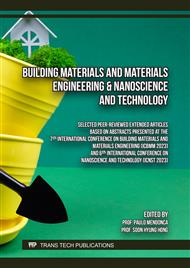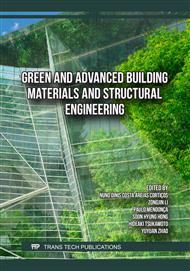p.3
p.11
p.17
p.25
p.33
p.43
p.49
p.55
Evaluation of the Thermomechanical Response of Geopolymeric Mortars Manufactured from Peruvian Mining Residues and its Comparison with Portland Cement Mortars
Abstract:
Geopolymeric mortars made from a mixture of waste from the Peruvian informal mining industry, sodium hydroxide activating solution, and fine sand were studied, comparing them physically and mechanically with conventional Portland cement mortars. Both conventional and geopolymeric mortars were prepared in parallel and then subjected to uniaxial compression tests at various temperatures (ambient, 200 °C and 500 °C). The mechanical results found revealed maximum average resistance values of 63, 84 and 79 MPa for conventional mortars, and 12, 32 and 36 MPa for geopolymeric mortars, when they were tested at room temperature, 200 °C and 500 °C, respectively. The best mechanical results in geopolymeric mortars were found when considering a binder: fine sand ratio of 1:2, molarity of the hardening solution of 12 M and a hardening solution: binder ratio of 0.6. It was possible to demonstrate a good agreement between the distribution of particle sizes observed microstructurally and those found by granulometry studies by laser light diffraction.
Info:
Periodical:
Pages:
3-10
Citation:
Online since:
December 2023
Keywords:
Price:
Сopyright:
© 2023 Trans Tech Publications Ltd. All Rights Reserved
Share:
Citation:



